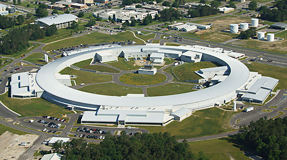Brookhaven National Laboratory Tours
Tour Date: Friday, October 5, 2018
Important Notes
- Some tours may visit active research facilities and may require guests wear long pants and flat, closed-toe shoes. Access may be restricted if proper attire is not worn. The conference organizers will provide further guidance as needed.
- NSLS-II is posted a Controlled Area. As such, a TLD (thermoluminescent dosimeter) may be required at the time of this tour. The conference organizers will provide further guidance as needed. All visitors must be 16 years old to be permitted on the NSLS-II experimental floor.
Facility Description

National Synchrotron Light Source II (NSLS-II)
NSLS-II is a state-of-the-art, 3 GeV electron storage ring designed to deliver world-leading intensity and brightness, and will produce x-rays more than 10,000 times brighter than the original NSLS. The facility offers scientific and industrial researchers an array of beamlines with x-ray, ultraviolet, and infrared light to enable discoveries in clean and affordable energy, high-temperature superconductivity, molecular electronics, and more.

Relativistic Heavy Ion Collider (RHIC)
RHIC is a world-class particle accelerator at Brookhaven National Laboratory where physicists are exploring the most fundamental forces and properties of matter and the early universe. RHIC accelerates beams of particles (e.g., the nuclei of heavy atoms such as gold) to nearly the speed of light, and smashes them together to recreate a state of matter thought to have existed immediately after the Big Bang some 13.8 billion years ago.

STAR Detector
The STAR detector specializes in tracking the thousands of particles produced by each ion collision at RHIC. It is used to search for signatures of the form of matter that RHIC was designed to create: the quark-gluon plasma (QGP). Detecting and understanding the QGP allows us to understand better the universe in the moments after the Big Bang, where the symmetries (and lack of symmetries) of our surroundings were put into motion.

Superconducting Magnet Division (SMD)
The Superconducting Magnet Division (SMD) designs and builds varied superconducting magnets for use in both particle accelerators and experimental facilities throughout the world. Current projects include the HTS solenoid for BNL's Energy Recovery LINAC, e Lens Solenoid LARP, APUL, correctors for J-PARC, Linear Collider Final Focus and high field magnet research and development.

Accelerator Test Facility (ATF)
The Accelerator Test Facility (ATF) is a proposal driven, Program Advisory Committee reviewed facility that provides users with high-brightness electron- and laser-beams. The ATF pioneered the concept of a user facility studying properties of modern accelerators and new techniques of particle acceleration over 25 years ago. It remains a valuable resource to the user community. ATF serves the U.S. DOE Accelerator Stewardship Program.

NASA Space Radiation Laboratory (NSRL)
The NASA Space Radiation Laboratory (NSRL) uses beams of heavy ions from the accelerators that feed RHIC to simulate space radiation and study its effects on biological specimens—such as cells, tissues, and DNA—and industrial materials. The National Aeronautic and Space Administration (NASA) and the DOE Office of Science partnered to build NSRL to identify materials and methods that reduce the risks astronauts will face on future long-term space missions.



